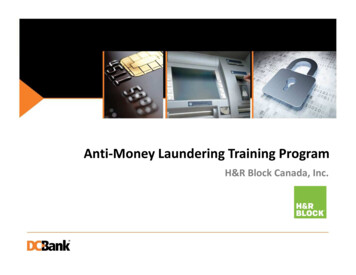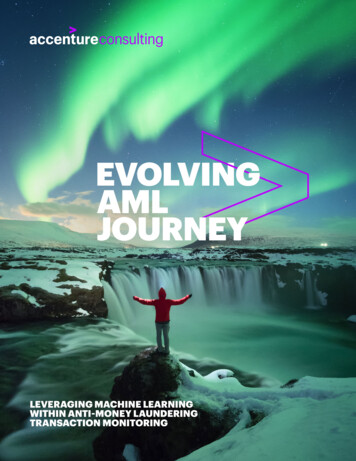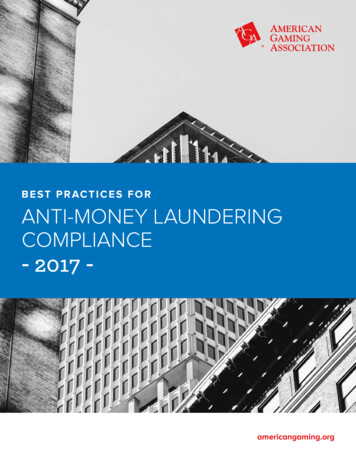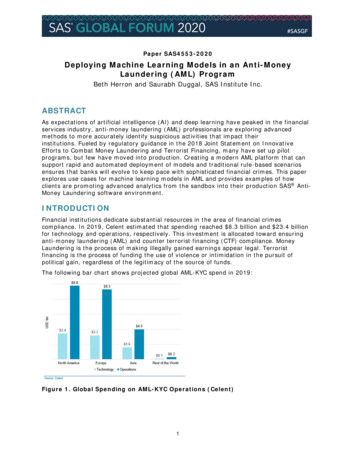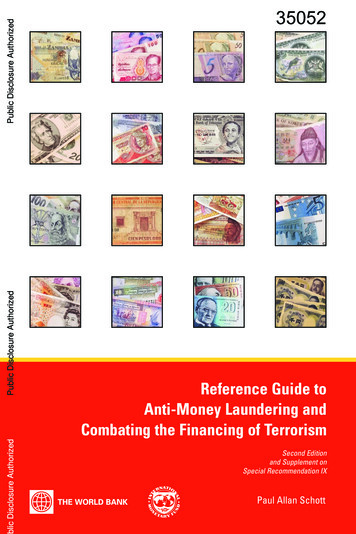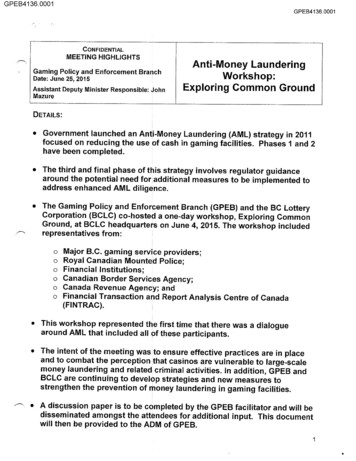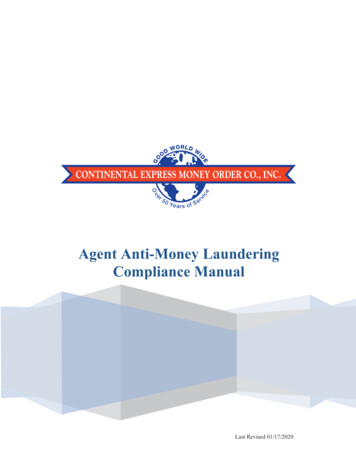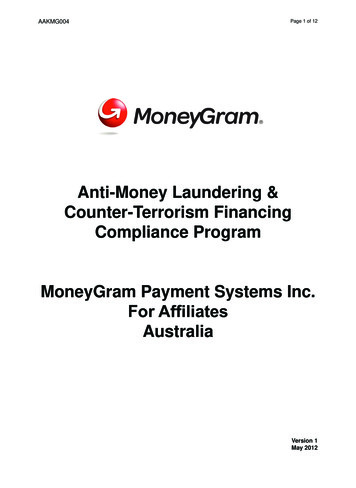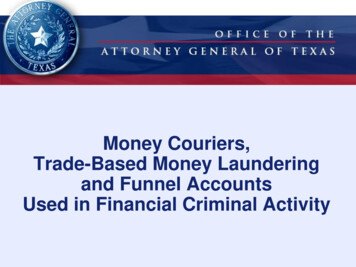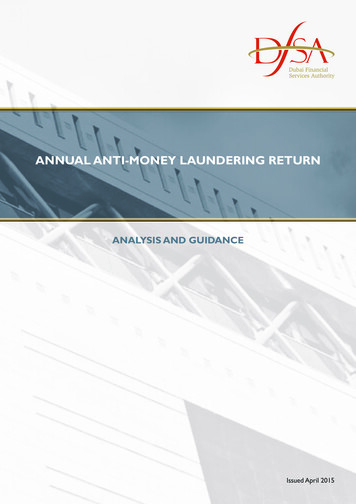
Transcription
ANNUAL ANTI-MONEY LAUNDERING RETURNANALYSIS AND GUIDANCEIssued April 2015
ContentsExecutive Summary3Background3Summary of Key Findings and Observations4Senior Management and Sign off4Assessment of Business Anti-Money Laundering Risk4Assessment of Customer Anti-Money Laundering Risk4Customer Due Diligence4Reliance and Outsourcing4Suspicious Activity Reports5Introduction6General Findings8Specific Findings9Senior Management Responsibility and Sign off (Section C1 & C7)9Money Laundering Reporting Officer (Section C2-6)9Assessment of business Anti-Money Laundering risk (Section D1)10Assessment of Customer Anti-Money Laundering risk (Section D4 & D5)12Customers (Section E1)14Customer Due Diligence (Section E6)17Ongoing Customer Due Deligence (Section E7 & E8)18Reliance and Outsourcing (Section F1 & F2)21Audit (Section G1-3)22Sanctions (Section H1-2)22Anti-Money Laundering Training and Awareness (Section I1-4)23Suspicious Activity Report (Section J1-3)24Preparing your next Annual Anti-Money Laundering Return226
Executive SummaryBackgroundIn July 2013, the Dubai Financial Services Authority’s (DFSA) new Anti-Money Laundering (AML),Counter-Terrorist Financing (CTF) and Sanctions Module of the DFSA Rulebook (the AMLModule) came into force. The key drivers for such changes were to: bring DFSA’s AML1 regime into line with the revised 2012 Financial Action Task Force (FATF)recommendations on combating money laundering and terrorist financing; and consolidate into one Module the DFSA’s AML requirements for Authorised Firms (AFs),Authorised Market Institutions(AMIs), Designated Non-Financial Businesses and Professionals(DNFBPs) and Auditors, collectively referred to as “Relevant Persons”.2One of the enhancements to the AML Module was the introduction of the Annual AML Return(AML Return) which replaced the Money Laundering Reporting Officer (MLRO) Report. Thenew AML Return has been designed specifically to provide the DFSA with targeted and specificinformation on a Relevant Person’s AML systems and controls.The findings of this report should be considered by all Firms in reviewing and implementing theirongoing AML programs. The findings are based on an analysis of the 2014 AML Returns; theyshould not be viewed as exhaustive but as guidance to be applied where relevant. As with anynew reporting requirements, the DFSA anticipated that the first round of Annual Returns wouldpresent a number of improvement opportunities. For example, some Firms failed to understandor misinterpreted the questions being asked in the AML Return. Many Firms also failed to considerthe specific rules which were referenced in the questions.In assessing these first submissions, the DFSA deliberately adopted a more lenient approach infeedback and criticism. Moving forward however given the guidance and feedback provided duringthe process and this report, the DFSA will have higher expectations for improvements in thetimeliness and quality of future submissions.The overall structure of the AML Return has been designed to mirror the relevant provisions inthe AML Module. Relevant Persons are required to provide both narrative and practical examplesdisplaying how it complies with its obligations under the AML Module. The AML Return also seeksspecific, qualitative data, for example, the number of particular clients or Political Exposed Persons(PEPs). Such data will assist the DFSA in better understanding the AML landscape and risks in theDubai International Financial Centre (DIFC).As importantly, the process of preparing an AML Return provides an opportunity for a RelevantPerson to conduct a self-assessment, which should assist in highlighting any key risk areas andimprovement opportunities. However, we remind Relevant Persons that the AML Return is not asubstitute for notifying the DFSA of relevant events as and when they happen.3123Any reference in this report to the “AML requirements/risks/obligations” should be read as a reference to the DFSA’sAML, Counter-Terrorist Financing (CTF) and sanctions regime.Any reference to a ‘‘Firm’’ should be read as a reference to a Relevant Person.See AML Rules 14.3.1 and 14.6.1.ANNUAL AML RETURN ANALYSIS AND GUIDANCE3
Summary of Key Findings and ObservationsSenior Managementand Sign off a significant number of Firms did not properly identify their seniormanagement and/or failed to obtain their acknowledgement andsign off. acknowledgement and sign off is one way that senior managementis able to evidence its oversight and responsibility for the Firm’scompliance with its AML obligations. the quality of the documentation of a Firm’s AML risk assessmentvaried from very good to very poor.Assessment ofBusiness AML Risk areas of improvements include the need for Firms to tailor theirassessments specifically to their business, and obtain buy-in fromall areas of the Firm including senior management, compliance andbusiness lines. most Firms displayed a good grasp of the factors that should betaken into consideration when assessing the specific risks posedby customers.Assessment ofCustomer AMLRiskCustomer DueDiligence (CDD) some customer risk assessments placed too great an emphasison the country or jurisdiction from which a customer was from,without considering the associated product or service risk. the assessment of customer risk should be appropriatelydocumented so that all information known of the customer forexample by their relationship manager can be collectively sharedwithin the organisation. most Firms were able to document and evidence the CDDprocesses undertaken when on-boarding new customers andsuch steps were generally well articulated and clear. areas of improvement include the requirement to conductongoing CDD such as transaction monitoring. many Firms appeared to rely on the fact that transactions werebooked overseas to not monitor transactions from the DIFC.Reliance andOutsourcing44Chapter 8 of AML Module a significant number of Firms misinterpreted questions in thissection and failed to appreciate the difference between placingreliance on, or outsourcing CDD measures to a third party4, fromusing a third party information vendor or screening software.
54 internal notifications relating to suspicious activities, and 50external SARs were lodged by FirmsSuspicious ActivityReports (SAR) The trigger for submitting an internal notification should be asexpansive as possible with the MLRO then acting as a secondstage and ultimately deciding if an external SAR should be lodged.Accordingly, the DFSA expected that the number of internalnotifications would be significantly higher than the number ofexternal SARs.The overall findings from the analysis of the 2014 AML Returns, confirms and supports the DFSA’scontinued focus on AML related risks. The above findings will assist the DFSA in preparing forany national AML risk assessment undertaken pursuant to the 2012 FATF Recommendations.Additionally, they will also assist in the scoping and setting of our AML regulatory priorities. Thismay include conducting a specific Financial Crime thematic review which may focus on: Risk-Based Approach - ensuring risk-based assessments undertaken are objective and proportionate,based on reasonable grounds, properly documented, and reviewed and updated at appropriateintervals;5 Ongoing CDD - assessing the appropriateness and quality of ongoing CDD, in particularongoing risk reviews and transactions monitoring;6 and Suspicious Activity Reporting - improving the internal escalation process for the notificationof suspicious activities and transactions and enhancing the quality of external SARs submittedto the Anti-Money Laundering Suspicious Cases Unit (AMLSCU) of the Central Bank of UAE.56Chapter 4 of the AML ModuleRule 7.6.1 of AML ModuleANNUAL AML RETURN ANALYSIS AND GUIDANCE5
IntroductionThe findings of this report resulted from the analysis of AML Returns submitted during 2014. Thereview was designed to make high level and general observations on how Firms approach AMLrisks in the DIFC. While individual submissions have been analysed, this report is published on ano names basis and should be considered as generic guidance. The review therefore, does notnecessarily contain any specific follow-up actions undertaken by the DFSA.Firms should contact their DFSA relationship manager, if one has been assigned or via the DFSAcontact portal if they have any questions.In terms of overall statistics, the following is noted: 279 AML Returns were considered for the purposes of this review; 233 of these were from AFs and 46 of these were from DNFBP; 90% of the AML Returns were received on time, or as result of an extension of time beingagreed with the DFSA; 37% of submissions required no or minimal follow-up from the DFSA; 63% of submissions required follow-up including requests for clarification, requests to providefurther information or requests to correct clearly erroneous information; and Total sample split by Firm and prudential category is illustrated overleaf:6
Total Sample Size 279 FirmsDNFBP16%AuthorisedFirms (AFs)84%DNFBPsAFsBreakdown of Authorised Firms in ReviewPIN13PIB Cat 4117PIB Cat 36416PIB Cat 2PIB Cat1and 520020406080100120ANNUAL AML RETURN ANALYSIS AND GUIDANCE1407
General FindingsThe AML Return was designed to be read and answered in conjunction with the AML Module.For ease of reference, the various components of the AML Return make reference to the relevantAML Rule. These rules should be consulted prior to answering each section to ensure that answersare relevant and in context.Overall, our analysis identified the following general issues regarding Firms understanding of andresponse to some of the questions in the AML Return. In particular : some Firms misinterpreted or did not understand the questions being asked. For example,Section C17 asks for the listing of “individuals forming the senior management of the firm.”The term senior management is a defined term in the AML Module and in these instancesrespondents simply named the SEO and Compliance Officer, omitting other members ofsenior management; some Firms did not answer the questions as required which resulted in insufficient detailsto assess the answer. For example, in Section D3, Firms are asked to “state the date ordates when the last risk assessment was carried out on the adequacy of its AML systems andcontrols.” Some Firms failed to provide a date or provided vague answers such as “routinely”; many of the questions asked in the AML Return are multi-facetted and require more than oneanswer. Using Section D3 as an example, it asks Firms “to provide or attach a summary of thefindings of this assessment.” Often this was not provided and no explanation provided for thefailure to answer.Lessons LearntIn order to improve the quality of future AML Returns, Firms should take into consideration thefollowing: read and completely understand the context of the question before attempting to answer it; consult with the AML Module and its glossary and be conscious of the use of defined terms; double check that the answer is complete and includes a response to each sub element,including why the Firm thinks an answer is not applicable or unanswerable; and provide specific numbers and dates, or an explanation as to why these cannot be providedwhen asked for specific information.78All Sections refered to in this Report are base on the most recent Annual AML Return - AML/VER3/03-15.
Specific FindingsSenior Management Responsibility and Sign off (Section C1 & C7)The DFSA believes that a significant influence on a Firm’s compliance culture is set by the “toneat the top”. To emphasise this, every individual who forms part of a Firm’s senior management,as defined in the AML Module8, is responsible for a Firm’s compliance with its AML obligations. Incarrying out their responsibilities every member of the Firms senior management must exercisedue skill, care and diligence.As such the following should be noted: where the AML Return seeks the names of all individuals forming the senior management ofthe Firm, that the named individuals (Section C1) meet the definition of senior managementcontained in the AML Module; the DFSA also requires that the AML Return be acknowledged and signed off by every memberof senior management. This ensures that those who are being held accountable for AMLcompliance within the Firm are aware of the contents of the AML Return; and in acknowledging and signing off on the AML Return, the DFSA values substance over form.Should senior management wish to acknowledge and signoff the contents of the AML Returnvia board resolution or other mechanism, evidence of such should be attached to the AMLReturn.It was encouraging to see many responses which displayed that senior management has a stronginvolvement in AML related decisions such as: actively participating in risk assessment discussions of the AML risks faced by the business,including new products; AML being a standing agenda item on Board meetings; and Board approval of enhancement opportunities identified during the completion of the AMLReturn.Money Laundering Reporting Officer (MLRO) (Section C2-6)The primary support mechanism to senior management in ensuring compliance with AMLrequirements is a Firm’s MLRO. The MLRO has oversight over day to day operations for AMLcompliance and acts as point of contact for employees by receiving internal suspicious activitynotifications. Further the MLRO acts as a point of contact for the DFSA and the AMLSCU.The AML Return responses provided the DFSA with a snapshot of MLROs in the DIFC and willalso allow the DFSA to monitor any changes, year on year. Some observations in relation toMLROs include:8As defined in Chapter 3 AML Module: Glossary for AML.ANNUAL AML RETURN ANALYSIS AND GUIDANCE9
nearly all Firms had a good grasp on the importance of the MLRO and were able to articulatetheir duties clearly in Section C4; approximately 35% of Firms used the services of an outsourced MLRO; over 80% of MLRO’s held other positions within the Firm, the most common pairing being aFirm’s Compliance Officer; and other pairings included being the Managing Director, Partner, Legal and Financial roles.Whilst the DFSA does not prohibit dual roles, Firms should be mindful of potential conflicts ofinterests that may arise and individual resourcing limitations when appointing a MLRO.The DFSA also notes the following concerns: Many Firms have centralised compliance and AML operations in another jurisdiction. Whilesuch arrangements may be advantageous in creating operational and commercial efficiencies,such arrangements should not usurp or replace the role of the MLRO. The MLRO as anindividual authorised by the DFSA is accountable and responsible for ensuring such centralisedfunctions are appropriate given the requirements of the AML Module; and A small minority of Authorised Firms (13%) had not appointed a Deputy MLRO9 to fulfil therole of the MLRO in his/ her absence. Common justifications provided for this failure includedthat “the MLRO was always contactable” or that the Firm has decided against appointing aDeputy “on a risk-based approach”. Such reasoning is not acceptable to the DFSA and failsto consider the adverse impact (however remote) of not having suitable coverage where theMLRO is absent.Assessment of Business AML Risk (Section D1)AML Rule 5.1.1 requires Firms to take appropriate steps to identify and assess money launderingrisks to which its business is exposed, taking into consideration the nature, size and complexity ofits activities.Unless a Firm understands the money laundering risks to which it is exposed, it cannot takeappropriate steps to prevent its business being used for the purposes of money laundering. Moneylaundering risks vary from Firm to Firm depending on the nature of its business, the customers ithas, and the nature of the products and services being provided.While the DFSA acknowledges that Section D1 of the AML Return is the first time that Firmshave been required to submit a copy of this assessment to the DFSA, the responses highlighted aneed for significant improvement in this area.9See AML Rule 11.2.3.10
Examples of good and poor practices are included in the tables below:Good Practices: the risk-assessment included input, discussion and acknowledgement from compliance,business lines heads and senior management and provided details as to how to mitigateeach risk; individual consideration of relevant risk factors e.g. complex company or legal structures,risks posed by potential customers from particular jurisdictions, risks posed by specificproducts including trade finance and private wealth management; references to material and information supporting the analysis of AML risks e.g. FATFMutual Evaluations reports, corruption indexes and AML indexes; an analysis of individual AML risks with conclusions on the likely impact these risks haveon the business; and identification of risks requiring additional due diligence, but equally as useful identifyingareas where the risks were lower and where simplified measures could be adopted.Poor Practices: some Firms had not undertaken any assessment as required by AML Rule 5.1.1, leavingSection D1 blank or referencing their AML policies and procedures which did not containany assessment of AML risks; poor quality assessments of business AML risks included assessments which merely restated the requirements of the AML Module Rulebook without any tailored considerationsof how these factors impacted the Firm. These assessments were vague and so high levelthat they could not have provided the Firm with any assistance in formulating their AMLcompliance programs; and some Firms provided generic risk managements reports which were not AML specific.The conduct, quality and documentation of the assessment of business AML risks will remain apriority on the DFSA’s AML supervisory agenda.ANNUAL AML RETURN ANALYSIS AND GUIDANCE11
Assessment of Customer AML Risk (Section D4 & D5)As required by AML Rule 6.1.1, a Firm must undertake a risk-based assessment of every customerand assign the customer a risk rating proportionate to the customer’s money laundering risk.Thisincludes: identification of the customer and any beneficial owners; ascertaining the purpose and nature of the proposed relationship; considering the customers country of origin, residence, nationality; considering the relevant product, service or transaction; and factoring in the outcomes of its business risk assessment.The DFSA recognises that there can be overlap between the assessment of business and customerrisks, though the assessment should nonetheless be carried out given that these assessments drivedifferent elements of the AML compliance program. A business risk assessment is most informativeand core to a Firm in developing its AML systems and controls, whereas a customer risk assessmentis a key element in determining risk rating and ultimately determines the appropriate level of CDD.Analysis of Sections D4, D5 and E2 of the AML Returns indicated that overall, the majorityof Firms are aware of the differing risk elements that should be considered in a customer riskassessment.The majority of Firms were able to provide evidence of the consideration of the range of factorsset out in AML Rule 6.1.1, through their policies and procedures, and provided templates andforms to document their analysis.12
Examples of good and poor practices are included in the tables below:Good Practices: a clearly documented formula and methodology for risk rating their customers, withdiffering and specific weightings placed on different risk elements such as product risk,quantum of customer investment, PEP status; development and implementation of above methodology into databases, spreadsheetsand other electronic systems to enhance automation efficiencies and ensure consistentapplication and documentary evidence of the assessment; utilisation of the guidance provided by the DFSA (AML Rule Guidance 6.2.1 point 10) withrespect to factors that may indicate a customer poses a higher risk of money laundering,or where such guidance is not applicable, the reasons for not considering the guidance isdocumented; and organised lists of their customers, categorising their AML risk and using such lists to informtheir ongoing CDD e.g. risk reviews and screening.Poor Practices: failure to document the reasoning behind the risk rating assigned to a customer; sole or over reliance on jurisdiction or country risk for determining a customer’s riskrating. This approach fails to take into account that not all individuals from the samecountry will present the same overall AML risk; Firms taking a blanket approach to risk rating customers, either assigning all customers astandard risk or high risk regardless of individual risk elements.This was more prevalentin Firms with small customer numbers but can result in either not enough, or too muchcustomer due diligence being undertaken. This is also likely to become problematic shouldcustomer numbers increase.As indicated above, the analysis of customer AML risk as part of a Firm’s overall risk-based approachwill remain a priority of the DFSA’s AML supervisory agenda.ANNUAL AML RETURN ANALYSIS AND GUIDANCE13
Customers (Section E1)The analysis of the AML Returns provides a good insight into customer numbers in the DIFC. Thebelow tables indicate customer numbers broken down by prudential category, and further thecustomer risk rating assigned by the Firm of the sample reviewed.Total Number of Customers by Firm CategoryTotal Number of Customers by Firm CategorySample Size 23,802 Clients1618PINPIB Cat 489284083PIB Cat 33050PIB Cat 2PIB Cat1and 000
Breakdown of Customers by Risk rating per Firm CategoryTotal number of customers in sample size 23,802 ClientsSample size 233 Authorised Firms23%PIN73%4%22%19%PIB Cat 463%25%13%PIB Cat 352%16%23%PIB Cat 248%29%PIB Cat1 and L AML RETURN ANALYSIS AND GUIDANCE15
Politically Exposed Person (PEP) (Section E4)In response to Sections E4 and E5, almost all Firms were able to provide an explanation of thesystems used to determine whether a customer or beneficial owner was a PEP.These systemsincluded third party screening and information vendors, internet searches and also PEP selfdeclarations, with the best systems utilising all of these mechanisms.Overall, 45% of respondents indicated that they had a PEP as a customer or had identified a PEPas a beneficial owner. The table below provides a breakdown of such respondents by prudentialcategory of the sample reviewed.PEPs per Firm CategoryTotal Number of PEPs 2889 PEPs4%28%25%13%30%PIN16PIB Cat1 and 5PIB Cat 2PIB Cat 3PIB Cat 4
Customer Due Diligence (CDD) (Section E6)Firms should undertake CDD in a manner (risk-based approach) which is proportionate to thecustomer’s money laundering risks.The information in Sections D2 and E6 of the AML Returns provided insight into each Firm’sapproach to CDD.Examples of good and poor practices are included in the tables below:Good Practices: CDD processes are well documented and in plain English; inclusion of flow charts and other aids to describe how CDD should differ for differentAML risks; and stressing that business cannot commence with a customer unless CDD is completed.Poor Practices: the lack of any meaningful differentiation between the levels of CDD. In an extreme example,the only difference in enhanced due diligence measures was obtaining one extra form ofidentification; and some Firms took a blanket approach to CDD, electing to apply the same level of CDDto all its customers. Such an approach is seen as being cautious if a higher level of CDDis applied than would be required, but it can also result in less CDD being completed inhigher risk circumstances.While not specifically considered in the report, the DFSA will continue to focus on how a Firmdocuments its understanding and verification of source of funds and source of wealth.ANNUAL AML RETURN ANALYSIS AND GUIDANCE17
Ongoing CDD (Section E7 & E8)AML Rules 7.6.1 and 7.6.2 set out the DFSA’s requirements relating to conducting ongoing CDDwhich includes: monitoring transactions undertaken during the course of its customer relationship to ensurethat the transactions are consistent with the Firms knowledge of the customer; paying particular attention to any complex or unusually large transactions or unusual patternsof transactions that have no apparent or visible economic or legitimate purpose; and inquireinto the background and purpose of these transactions ; reviewing periodically the adequacy of the CDD information it holds on customers andbeneficial owners to ensure that the information is kept up-to-date; reviewing periodically each customer to ensure that the risk rating assigned to a customerremains appropriate for the customer; and reviewing its customers, their business and transactions against United Nations Security Councilsanctions lists and against any other relevant sanctions lists (e.g OFAC, EU & HMT).An unexpectedly high number of Firms answered “not applicable’ or provided no answer toSection E7, which sought an explanation of how a Firm undertakes ongoing monitoring of itscustomers and their transactions.Transaction MonitoringIt was observed from the AML Returns that many respondents erroneously relied on the fact thattransactions were booked in locations outside the DIFC to not answer this question. In such circumstances, the DFSA accepts that while any AML risk is shared with the bookinglocation, this does not remove the responsibility from the DIFC Firm to monitor transactionsto ensure that they are consistent with their knowledge of the customer; a Firm’s transaction monitoring program should take such circumstances into consideration,and where monitoring is undertaken at the booking centre, the DIFC Firm should ensure thatthe findings and alerts generated from this system are shared. This may include the lodgementof SAR in both jurisdictions; and where appropriate a Firm may place reliance on a third party entity, but such reliance shouldadhere to the DFSA’s requirements in Chapter 8 of the AML Module. A Firm may alsoconsider whether additional comfort can be gained from periodic sample testing of “reliedupon’ processes.18
Review of CDD InformationSection E8 of the AML Return concerned the frequency of a Firm’s review of the adequacy ofCDD information it held on its customers and beneficial owners. An analysis of this information(which is summarised in the chart below) revealed that: 41% of respondents conducted continuous or rolling reviews of their CDD, which allowed theworkload to be spread over time; 22% of respondents had a fixed date in which CDD for all customers was reviewed; 14% of respondents used an event driven process for review, triggered only when newinformation was brought to light about the customer or when a new service or transaction isrequested; and 23% of respondents used a variety of other means, including monitoring being driven from aparent or other group entity; or were newly authorised Firms with no or very small customernumbers.Ongoing CDD Review Frequency23%41%22%14%OtherContinous CDDEvent DrivenFixed PeriodANNUAL AML RETURN ANALYSIS AND GUIDANCE19
Examples of good and poor practices are included in the tables below:Good Practices: the ongoing CDD process is clearly described in AML policies, these were supplementedby compliance calendars which set out the key review dates; Firms using software solutions and platforms to automatically screen against sanctions listsand customer transactions; CDD information is electronically captured with accompanying flags which indicatedexpiry of static information such as passports and IDs; and screening software scrubs against batch lists of key names and entities including customers,beneficial owners and known associates, on an ongoing basis, generating real time alerts.Poor Practices: reviews which were initiated only when a customer informed of changes, for examplechange in address; or where the RM became aware of changes through ad hoc means asopposed to designated review dates; reviews only being initiated when a new service or product is requested which do nottake account of non transaction risk factors, such as listing on a sanctions list, or change incustomer details; over reliance on screening software, without sufficient evidence of operationalunderstanding of how software works. Firms should understand how screening softwareoperates and which data is being searched; sole reliance on third parties without meeting DFSA requirements, or in circumstanceswhere the Firm does not understand the nature of the monitoring being undertaken bythe third party; and CDD information only gathered and analysed at on-boarding stage but then not subjectto any review.Firms’ ongoing CDD policies, procedures, systems and controls are one of the most importantaspects of effective CDD. Given the DFSA observations regarding deficiencies (poor practices)in implementing ongoing CDD, this area may also be explored further through a number ofsupervisor tools including thematic reviews.20
Reliance and Outsourcing (Section F1 & F2)Sections F1 and F2 of the AML Return relates to placing reliance on and/or outsourcing elementsof CDD to third parties. Chapter 8 of the AML Module was designed to allow Firms to placereliance on specified third parties to conduct one or more elements of CDD on its behalf. Thespecified third parties include: another Authorised Firm; a law firm, notary or other independent legal business, accounting firm, audit firm or insolvencypractitioner or an equivalent person in another jurisdiction; a financial institution; or a member of the firm’s
Assessment of Customer Anti-Money Laundering risk (Section D4 & D5) Customers (Section E1) Customer Due Diligence (Section E6) Ongoing Customer Due Deligence (Section E7 & E8) Reliance and Outsourcing (Section F1 & F2) Audit (Section G1-3) Sanctions (Section H1-2) Anti-Money Laundering Training and Awareness (Section I1-4)
